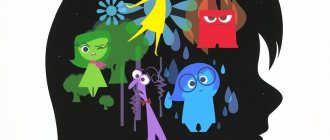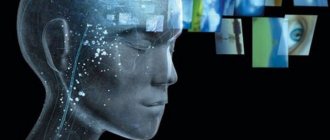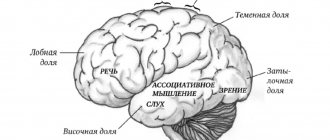9 - 2011 Sofya Skrylina, teacher of information technology, St. Petersburg
Visual perception is a set of processes for constructing a visual image of the surrounding world, the ability to comprehend what you see. These processes provide the perception of color, space, direction and shape of objects. When examining an object, a person always tries to understand what he sees. But what he saw does not always correspond to reality. There are objective patterns of visual perception that a designer must know and use in his work. After all, the success of his final product primarily depends on how the consumer perceives it.
Features of visual perception
Consistency and selectivity
When looking at any objects, the eyes move, simultaneously and in concert. The eyes are designed in such a way that they can recognize only one image at a time, then move on to the next, etc. It turns out that a person looks sequentially. The gaze moves from one part of the image to another, repeating the same path several times. The fragments of the image that a person looks at most often are the centers of meaning. In Fig. Figure 1 shows an example of the trajectory of eye movement when viewing the profile of Nefertiti.
As can be seen from the trajectory, the main elements on the face that attract attention are the eyes, nose and lips. And from a variety of objects, in most cases the choice will fall on the image of a person or an animal.
Rice. 1. An example of the trajectory of eye movement when viewing the profile of Nefertiti
The points at which, when viewing an image, the eyes stop and change direction are called the points of maximum curvature of a given section of the contour. Such points are most important for identifying a figure. Sharp breaks in lines are used in cross stitch and carpet designs, and are often used by artists to achieve greater expressiveness and stylization of images (Fig. 2).
Rice. 2. “Peasant Woman” by Ivan Goryushkin-Sorokopudov as an example of a drawing with sharp breaks in lines
Reaction to movement
The visual apparatus is designed in such a way that when a moving object appears in the field of view, the gaze is almost instantly transferred to it, and then tracks the movement. This property of the eyes is widely used by professional designers to attract attention to commercials, animated presentations, scrolling text, etc.
Integrity of perception
A person is able to imagine and see the image as a whole, looking at its individual parts. Several random curved lines, perceived as a whole, can create a new and unexpected image. A person subconsciously tries to combine the elements of an image. Examples of such simple pictures are shown in Fig. 3.
Rice. 3. Examples of holistic perception of lines
Memorability
Of the many elements of the image or object under consideration, a person can simultaneously perceive and remember no more than 7-9 in a short time. Look at the picture for a few seconds (Fig. 4), close your eyes and try to remember the fragments you saw. Most likely, there will be no more than nine of them. When creating complex compositional works, posters and exhibitions, do not forget this property of perception, do not overload your work.
Rice. 4. Rembrandt. Musical part
Constancy
Constancy of visual perception is the relative constancy of the size, shape, color of objects that are perceived when the distance, angle, and illumination change. Thus, constancy is the ability to recognize objects from different points of view, in different projections. The constancy of perception is ensured by experience, which is acquired in the process of individual development of the individual. If perception were not constant, then with every step, turn, movement, change in illumination, we would not be able to recognize what was previously known. Thanks to constancy, we can assign a seen object to the desired class, for example, combine all conceivable images of cats into one concept “cat” (Fig. 5).
Rice. 5. An example of constancy of perception
Correlativity
Correlativity is the ability of perception, expressed in the fact that all the properties of some objects are perceived in comparison with the same properties of other objects. If there is only one item in the picture, you probably won't be able to tell whether it's big or small. You should place it in some kind of environment, surround it with other objects, and compare its size with the known sizes of other objects (Fig. 6).
Rice. 6. An example of the perception of an object depending on its environment
Correlativity allows you to enhance the impression of multicolored images when using a limited number of colors: dark on a light background seems darker, and vice versa (Fig. 7).
A person’s subconscious desire to compare objects sometimes leads to visual errors and illusions.
Rice. 7. Dependence of color perception on contrast: the upper (lower) part of the inner rectangle located on the right appears significantly lighter (darker) than the same part of the rectangle located on the left
Everything that surrounds us is a sign. Everything is a code
Visual communication should be considered as the process of transmitting information using visual language. This is a language of special symbols, logos, graphic and media elements. The cognitive basis of visual communication is its ability to engage and stimulate the activity of both hemispheres of the brain, allowing not only to convey target information in the most effective way, but also to ensure its assimilation.
As S. L. Rubinstein noted, in the process of phylogenesis, man was formed as an “optical being.” The role of visual images is very great, because 75% of the information we receive comes from vision, which gives us the most perfect, genuine perception of objects [6].
Illusory
Illusory - errors in visual perception, optical illusion. There are several causes of visual illusions:
- Sometimes illusions appear as a result of specially created, special observation conditions, for example, observation with one eye, with fixed axes of the eyes, through a slit, etc. Such illusions disappear when unusual viewing conditions are removed.
- The overwhelming majority of visual illusions arise not because of the optical perfection of the eye, but because of a false judgment about what is visible, so we can assume that deception here arises when comprehending the visual image. Such illusions disappear when observing conditions change, when simple comparative measurements are performed, and when certain factors that interfere with correct perception are eliminated.
- There are a number of illusions known that are caused by the optical imperfection of the eye and some special properties of various analyzers involved in the visual process (retina, nerve reflexes).
Let's look at graphic illusions in images as examples.
Introduction
Our overall visual perception depends on many factors. Measuring visual acuity using the Snellen high-letter contrast chart provides information on just one measure of overall visual perception. Although visual acuity is the most frequently measured quantitative parameter in clinical practice, it actually poorly correlates with the dynamic range of tasks performed by the human visual system in real-world conditions [1]. To more fully describe people's overall level of satisfaction with visual perception, it is necessary to take into account factors such as spatial orientation, discrimination efficiency, and duration of visual perception without fatigue [2]. In addition, and this is especially true for CL users, it should be taken into account that the general feeling of visual comfort includes a combination of visual and physical sensations [3]. This article examines the key parameters for assessing the effectiveness of visual perception and their role in overall satisfaction with vision in real-world situations, as well as the possible influence on this perception of the design and material of corrective lenses.
Illusions associated with the structural features of the eye
Blind spot
The presence of a blind spot on the retina was first discovered in 1668 by the famous French physicist E. Mariotte. The fact is that the retina of the eye in the place where the optic nerve enters the eye does not have light-sensitive nerve fiber endings. Therefore, images of objects falling on this place of the retina are not transmitted to the brain, and therefore are not perceived. A blind spot, it would seem, should prevent us from seeing the entire object, but under normal conditions we do not notice this. In Fig. 8 the disappearing figure is replaced by a white background. Close your left eye and look with your right eye at the cross shown on the left, holding the drawing at a distance of 1520 cm from the eye. At a certain position of the drawing relative to the eye, the image of the oval ceases to be visible.
Rice. 8. The illusion of a disappearing figure
Irradiation
Many illusions are based on the irradiation effect (from the Latin irradio - to shine, to emit rays), which occurs when observing light figures and objects on a black background and vice versa. Look closely at the black square on a white background and the white square on a black background (Fig. 9). The white square appears larger than the black one. This is an optical illusion. In fact, the squares are exactly the same.
Examples of illusions of non-parallelism of parallel lines are also based on the irradiation effect (Fig. 10).
Rice. 9. A white square on a black background appears larger than a black square on a white background.
Rice. 10. A specially selected combination of various design elements creates the illusion of distorted parallel lines
Illusion of movement
Take a close look at the images in Fig. 11. You will see that the fish are swimming, the star is pulsating, and the circles are rotating.
Rice. 11. The illusion of moving objects
What does a person see
Thanks to vision, we receive 90% of information about the world around us, so the eye is one of the most important sense organs. The eye can be called a complex optical device. Its main task is to “transmit” the correct image to the optic nerve.
Structure of the human eye
The cornea is the transparent membrane that covers the front of the eye. It lacks blood vessels and has great refractive power. Part of the optical system of the eye. The cornea borders the opaque outer layer of the eye, the sclera.
The anterior chamber of the eye is the space between the cornea and the iris. It is filled with intraocular fluid.
The iris is shaped like a circle with a hole inside (the pupil). The iris consists of muscles that, when contracted and relaxed, change the size of the pupil. It enters the choroid of the eye. The iris is responsible for the color of the eyes (if it is blue, it means there are few pigment cells, if it is brown, it means a lot). Performs the same function as the aperture in a camera, regulating the light flow.
The pupil is an opening in the iris. Its size usually depends on the light level. The more light, the smaller the pupil.
The lens is the “natural lens” of the eye. It is transparent, elastic - it can change its shape, almost instantly “focusing”, due to which a person sees well both near and far. Located in the capsule, held in place by the ciliary band. The lens, like the cornea, is part of the optical system of the eye. The transparency of the human eye lens is excellent, transmitting most light with wavelengths between 450 and 1400 nm. Light with a wavelength above 720 nm is not perceived. The lens of the human eye is almost colorless at birth, but becomes yellowish with age. This protects the retina from exposure to ultraviolet rays.
The vitreous is a gel-like transparent substance located in the back of the eye. The vitreous body maintains the shape of the eyeball and is involved in intraocular metabolism. Part of the optical system of the eye.
Retina - consists of photoreceptors (they are sensitive to light) and nerve cells. Receptor cells located in the retina are divided into two types: cones and rods. In these cells, which produce the enzyme rhodopsin, the energy of light (photons) is converted into electrical energy of the nervous tissue, i.e. photochemical reaction.
The sclera is the opaque outer layer of the eyeball that merges at the front of the eyeball into the transparent cornea. 6 extraocular muscles are attached to the sclera. It contains a small number of nerve endings and blood vessels.
The choroid - lines the posterior part of the sclera, adjacent to it is the retina, with which it is closely connected. The choroid is responsible for the blood supply to intraocular structures. In diseases of the retina, it is very often involved in the pathological process. There are no nerve endings in the choroid, so when it is diseased, there is no pain, which usually signals some kind of problem.
Optic Nerve - The optic nerve carries signals from nerve endings to the brain.[6]
A person is not born with an already developed organ of vision: in the first months of life, the formation of the brain and vision occurs, and by about 9 months they are able to almost instantly process incoming visual information. In order to see, light is needed. [3]
Illusion of whole and part
Many erroneous visual impressions are due to the fact that we perceive figures and their parts not separately, but always in some relationship with other figures surrounding them, some background or setting. This section includes, perhaps, the largest number of visual illusions encountered in practice.
Müller-Lier arrow illusions
In Fig. Figure 12 shows three illusions of arrows by the famous German sociologist Müller-Lier. The illusion on the left is that the topmost horizontal arrow appears shorter than the bottom ones, but in fact all three are equal. In the picture in the middle, the imaginary lines connecting the ends of the arrows appear slanted, although in fact they are vertical. In the picture on the right, the red dot is exactly in the center of the horizontal line, although the left line appears to be smaller.
Rice. 12. Examples of Müller-Lier arrows
Ebbinghaus illusion
The Ebbinghaus illusion, or Titchener circles, is an optical illusion in the perception of relative sizes. In Fig. 13 shows two series of circles. The black circle on the right appears to be larger than the one on the left, although in fact they are the same size.
Rice. 13. Classic illusion of object size distortion: the inner circles are the same in both cases
Visual, auditory, kinesthetic, digital in the learning process
If you study a lot, go to courses, trainings, read, then understanding your own type of perception will help you organize your own learning process with maximum benefit.
Visuals
The basis of their learning is visual information. For visual people, hearing and vision form a single whole, therefore, if such a person only heard the material (but did not see), then with a high degree of probability the information will be quickly forgotten. Visual learners instantly absorb all visual information, so it is most beneficial to use all methods and techniques for visually presenting the material:
- mind maps
- scheme
- graphs
- illustrations
- photos
- demonstration models
- experiments, experiments
Visual learners learn best through visual examples, where they see the material they are learning in real time. Primary memory is visual. They remember well the location of objects, paths, roads, and are well oriented in space. Some noise is not critical for a visual learner; he can concentrate in an environment of some noise and successfully study the material.
Visual learners perceive text information well and are able to quickly learn speed reading.
Audial
Uses the auditory perception channel as a trigger. Inner speech is moderately developed. They perceive lectures, music, conversations, and dialogues well. They clearly and effectively maintain the line of conversation and conversation; often it is during the conversation that they grasp the meaning of the material being studied. Silence is necessary when concentrating. If you are an auditory learner, then be sure to listen to lecture material and audio courses. Learn together with others, discussing the topic being studied, thinking out loud about the problem.
Kinesthetic
Receives information through actions and movements. He remembers any actions and practical exercises well. He perceives all information best through practical exercises and experiments, where he tests the information received with his own hands in practice. Information of a practical nature is especially well perceived: what moves and how, where to click.
It is important for kinaesthetic learners to feel, touch, smell, taste and fully experience the subject being studied. People of this type are very active, love and enjoy working. And they don’t like inaction. It is for kinesthetic learners that the saying “Movement is life” has a special meaning. It is very difficult for kinaesthetic people to maintain focus, they are easily distracted, it is difficult for them to sit still for a long time, or to do routine work.
Digital
They are well trained in all sciences that have strict logic and consistency: mathematics, physics, mechanics, technology. Such people often work in areas where there is a lot of research, mathematical and static processing, and programming. The main thing for digital is to understand the logic and connections in the material, to organize what is being studied into a system with clear cause-and-effect relationships. Therefore, during your studies, try to build the logic of the entire topic being studied. For this you can use:
- scheme
- mind maps
- compressed plans
- Personally compiled thesauri
Revaluation of vertical lines
A person determines horizontal distances more accurately by eye than the height of objects. Therefore, most people exaggerate the vertical extent compared to the horizontal, and this also leads to visual illusions. If you ask a number of people to draw vertical and horizontal lines of the same length, then in most cases the drawn vertical lines will be shorter than the horizontal ones. When the eye divides a vertical line in half, the middle is usually too high (Fig. 14a).
Rice. 14. The illusion of vertical and horizontal lines: a - it seems that the height of the triangle is not divided into equal parts; b - a figure made of horizontal lines seems narrower and taller
In Fig. 14b it seems to us that the right figure is narrower and higher (the gaze slides vertically) than the left figure. In fact, both of these figures are shaded squares with equal sides.
Ancient symbol
The perception of a sign developed in direct dependence on the laws of the psychology of visual perception. One of the earliest forms of visual communication is rock painting. Our predecessors were able to capture, with the help of conventional drawings, some details of their lives. They transmitted information, a special encoded message, the decoding of which did not require special knowledge; all knowledge was based only on the intuitive perception of the object [9].
Initially, there were two main figures: a point and a line. By combining them, it was possible to create only schematic images.
Gradually, the rock paintings became more complex, the number of drawn objects increased, and a plot appeared. New figures also appeared, namely: circle, triangle, square. This was the basic geometric set, which is still the basic one.
By transforming this basic set it was possible to obtain an oval, a diamond and a rectangle. By adding new geometric elements, more complex figures were obtained, three-dimensional forms appeared in the form of a ball, a pyramid and a parallelepiped. With the development of rock art, other forms of visual communication also developed: sculptures, drawings on fabric and household items. There was also a need for self-identification, to fully correspond to one’s social group. Now it was very important to introduce a special meaning into the sign, which only someone who was well acquainted with the specifics of the visual language and symbols of a particular people, a particular culture, could reveal. It happened that one symbol was interpreted differently in different cultures. This tendency most often appeared in various religious movements, and later in secret societies and schools.
The desire to be a member of the brotherhood, part of one’s culture, obliged one to be like one’s like-minded people and to actively use symbols related to their culture. And here the sign was perceived as an indicator: who this person is, what group he belongs to. This need for self-identification continues to this day. A person identifies himself with different communities and with the same activity uses the symbols of the cultural or religious area that he prefers.
Exaggeration of sharp corners
Many illusions are explained by the ability of our vision to exaggerate the sharp angles we see on flat figures. Perhaps this kind of illusion arises due to the phenomenon of irradiation, since the light space we see expands near the dark lines delimiting the acute angle. The direction of eye movement and their mobility in general are of great importance for these illusions. If there is a break in the lines, then our gaze first falls on the acute angle.
Sharp corners always seem larger than they actually are, which is why certain distortions appear in the relationship between the parts of the visible figure. In Fig. 15 parallel straight lines, due to the influence of the background, appear non-parallel and curved.
Rice. 15. Illusions of non-parallelism of parallel lines
Illusion of distortion of right angle and circle
Sometimes a change in the direction of lines and distortion of the shape of a figure occurs due to the fact that the eye follows the directions of other lines in the field of vision. In Fig. 16a, the sides of the square look slightly convex against the background of concentric circles, but in Fig. 16b, the circle appears somewhat distorted against the background of diverging rays.
Rice. 16. Illusions of distortion of right angles and circles
Perceptual challenge
Man has created and continues to create an artificial habitat, projecting in external images the states of his inner world, both emotional and intellectual. Human consciousness uses decoding as a cultural basis of cognition [5]. However, the message is always primary; in its structure, every message is a text, and then an image. The text is transformed into an image, and the image is always textual. The world is visualized, where the text is filled with an image. Objectively, the text cannot exist without visual compensation, but the visual structure does not exist without textuality, otherwise it is simply meaningless.
The modern solution is a new textuality. This is, first of all, textuality of the second level, that is, a text that includes a visual structure (textuality of the first level is text in its pure form without distracting visual elements). It has become possible to combine image and text, where one is form, and the other is content [10]. In order not to lose the integrity of culture, it is necessary to use a second-level text, which is also valuable because it fits into modern technologies.
Modern communication design strives to become hyper-communicative, actively using the latest technologies. Attempts to overcome single-level text go back to the idea of “visual text”. Thus, text and visual image become one equivalent level, thereby moving into another, more complex system, where the medium is the content itself.
Article Philosophy and psychology of the sign 41-46
- 43.jpg
- 44.jpg
- 45.jpg
- 46.jpg
- 41.jpg
Associativity
Associativity establishes connections between individual representations, as a result of which one of them causes a second, a third, etc. Let us take as a simple example the emotional visual perception of a line. When looking at different lines, different feelings and emotions arise. Different shapes of lines, their direction are elements of expressiveness:
- thick, bold lines make the shape heavier, creating the impression of weight, mass;
- vertical lines evoke a feeling of stability, convey upward striving, growth, solemnity;
- horizontal - symbolize solidity, peace, silence;
- spiral - characterize rotational movement, development;
- broken lines - associated with aggressiveness, imbalance;
- wavy - express movement of varying speeds;
diagonal and oblique - symbolize dynamics:
- ascending lines are associated with hope, takeoff, rise,
- descending - cause a feeling of instability, sadness, melancholy, powerlessness.
Visual revolution
The socio-cultural environment of human activity since the beginning of the 21st century has been predominantly visually oriented. The modern idea of the world, where vision plays a decisive role, is based on visual images that determine the picture of reality. The visual forms themselves are used and presented in modern culture as corresponding to certain emotions, states, events, behavioral stereotypes, age and social characteristics of people.
From birth, a modern person is surrounded by a rich media environment that carries most of the information about the world; Thanks to the development of computer multimedia technologies and global information networks, also predominantly visually oriented, a unique opportunity has emerged, on the one hand, for communication with the entire cultural heritage of humanity, and on the other, for a targeted change in the content and structure of human consciousness.
It is the visual environment that creates the dominant tone of a person’s worldview; information flows carry a certain content, have a certain intensity and tempo-rhythmic characteristics. Visual communications in modern society are increasingly moving away from the role of a passive mediator, “overgrown” with codes and acquiring a pronounced manipulative character.
Russian designers: Ludwig Bystronovsky, Erken Kagarov, Egor Zhgun, Natalya Moskaleva, Mark Rodionov, Sergey Steblina
With the advent of modern technologies, special programs, and full-fledged graphic editors, human capabilities in creating elements of visual communication have expanded significantly. The need to convey information using symbols has increased greatly. Now we needed signs, emblems and symbols that would be understandable to everyone, and communication with which would be extremely simple. The modern system of symbols and notations is even simpler in design than the first rock paintings. Every year there is a clear tendency to simplify signs, use a minimum set of graphic elements, and free them from “extra” details.
Article Philosophy and psychology of the sign 17-18
- 17.jpg
- 18.png
Interestingly, along with the simplification of the elements in its details, its color scheme is also simplified. Saturated bright colors are gradually being abandoned in order to make visual communication between the recipient and the symbol as calm as possible, not irritating, and not causing additional emotions.
Imagery
Imagery is the ability to excite artistic images in the mind, based on associativity. For example, the sight of a sea shell evokes the ocean, the depths of the sea. Sometimes an object that has never been seen before contributes to the emergence of some close, long-familiar image.
In psychodiagnostics, to assess the emotional attitude to the world around us, the Rorschach test is used, which consists of ten standard tables with black-and-white and color symmetrical amorphous images (“Rorschach spots”). The subject is asked to answer the question about what is depicted or what what is depicted looks like (Fig. 17). Attitude to color is an indicator of emotional state, and the degree of originality of answers characterizes intelligence.
Rice. 17. Examples of Rorschach blots
Virtuosity
From a geometric set of shapes, various combinations and designs were created, the composition of which became much more complicated over time. Elements were added in order to more accurately convey the shape, structure, mood of the depicted object, and therefore the meaning, the encrypted code.
Gradually, the authors of visual communication symbols achieved virtuosity in its execution. Now the symbol has become not a simplified sign, but a special form of art. Here skill was primary. The popularity of both the element and the author-performer depended on how skillfully the author depicted this or that element.
The value orientation shifted towards the author's principle, and each of the masters wanted to succeed in their business more than others. Rivalry between creators arose, and cultural, religious groups and organizations needed not just special signs and special designations, but skillful depiction and execution of all the elements contained in them. But the sign as a type did not become more complicated. It remained the same, taking on a more artistic form
(Maximilian Lenz, "Peace" 1899)
All images are man-made. An image is a recreated vision. A phenomenon taken out of space and time where it first appeared and preserved for a few moments or for several centuries. Every image embodies a way of seeing. Even photography, contrary to popular belief, is not an automatic fixation. The perspective, angle, and subject of a photograph are always unique. And although every image embodies a certain way of seeing, our perception and evaluation, in turn, depend on our own way of seeing [4].
Every element of visual communication must express something. This means, first of all, that its content must be something more than a simple image of objects. Such a definition expands the concept of “expression” for any type of communication. For example, we usually say that a person “expresses his opinion.” However, the expressiveness of a sign is a more specific phenomenon. It requires that the connection of sense data give rise to “perception,” the active presence of forces that constitute the perceived pattern. But how is such perception achieved?
From the position of associative psychology, Theodor Lipps suggested that the perception of expressiveness implies the activity of forces. His theory of "feeling" was intended to explain why we find signs of expressiveness even in such inanimate objects as palace columns. The meaning of the theory was as follows: “When I look at the columns, based on my past experience, I know about the presence of mechanical compression and stretching in them. Also, from past experience, I know how I myself would feel if I were in the place of the column and if physical forces acted on my body from outside and inside it. I project my own kinesthetic sensations onto the column. In addition, the sensations of compression and stretching, which are taken from the “storehouse of memory,” tend to provoke a reaction in other areas of consciousness” [3].








